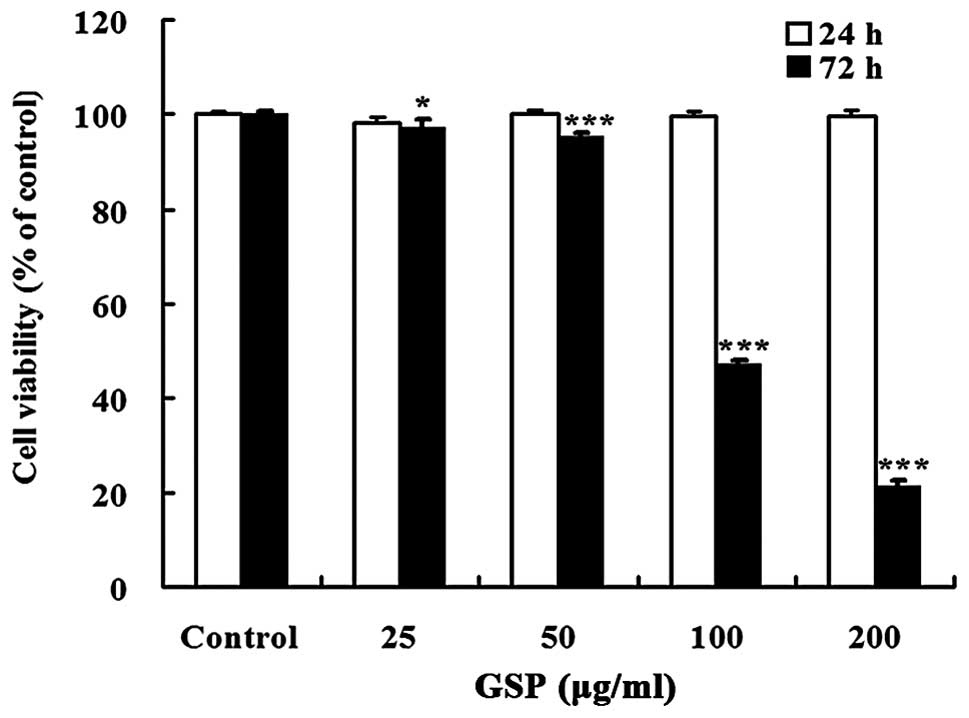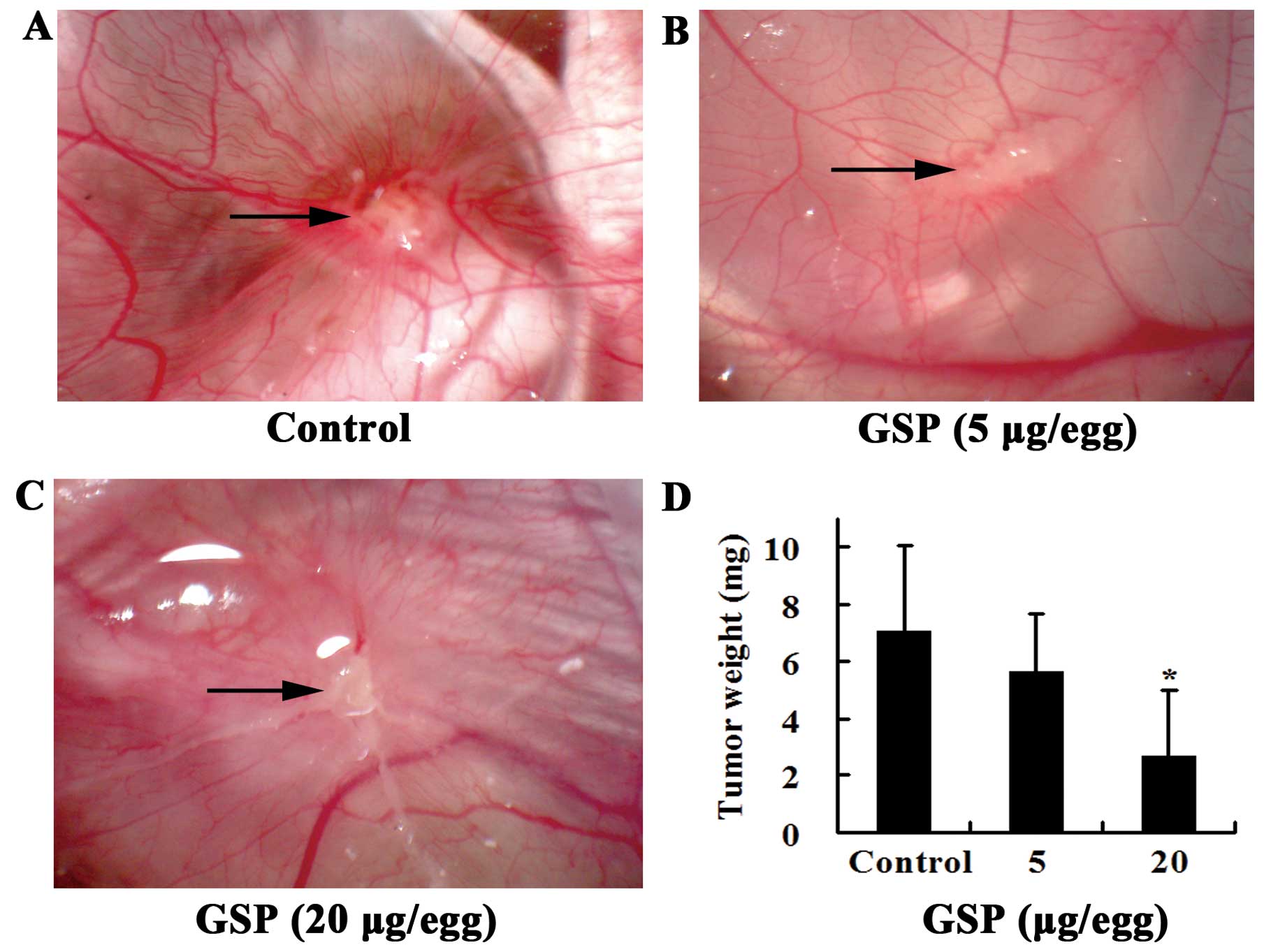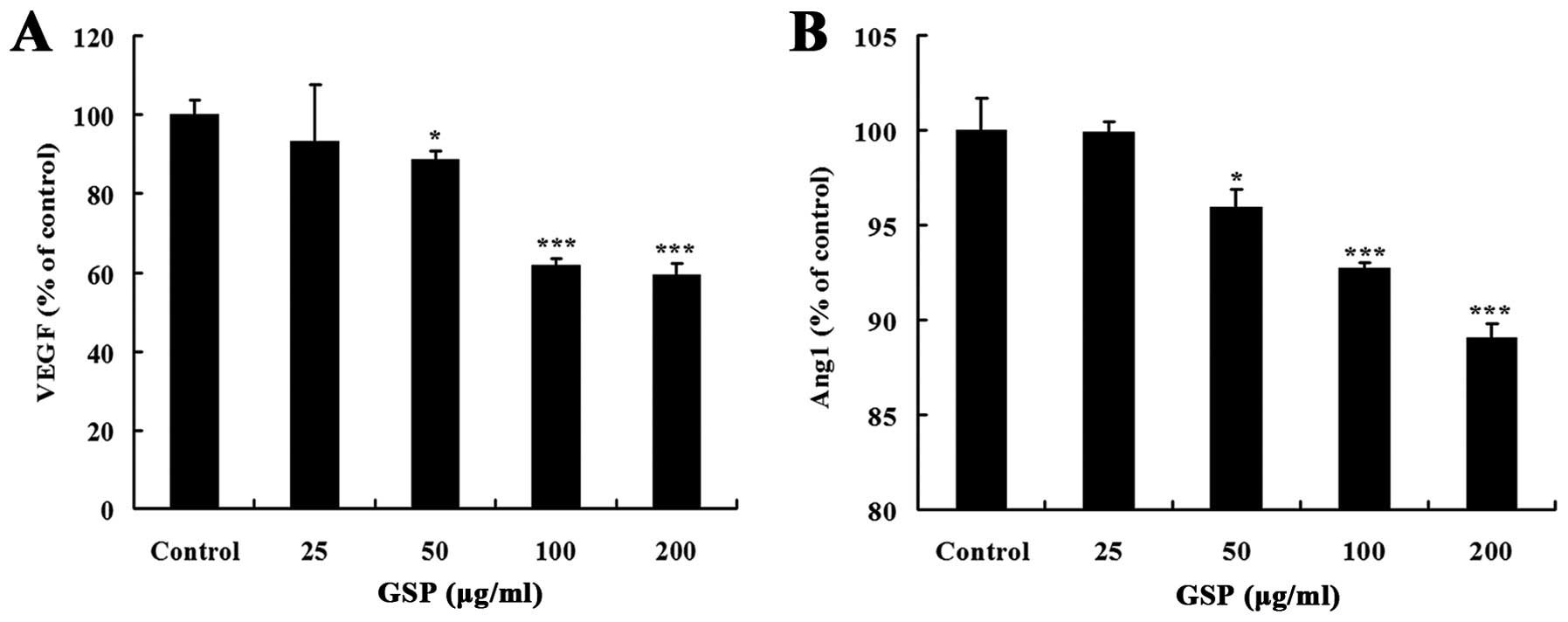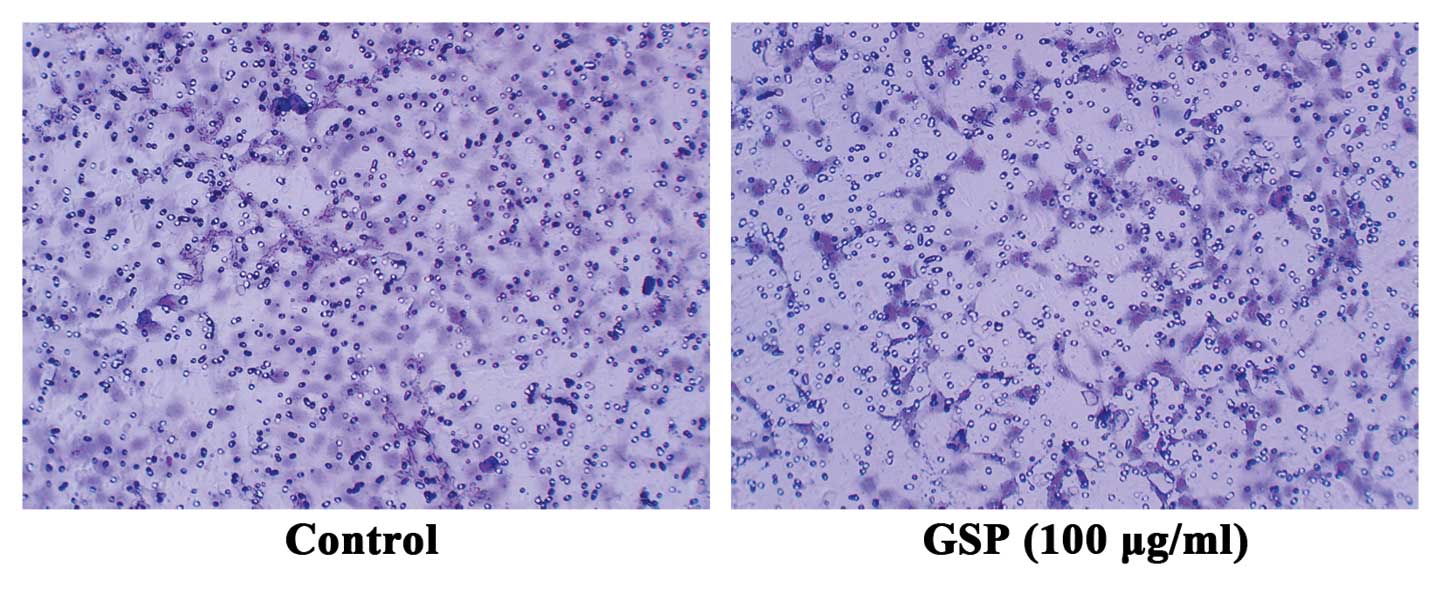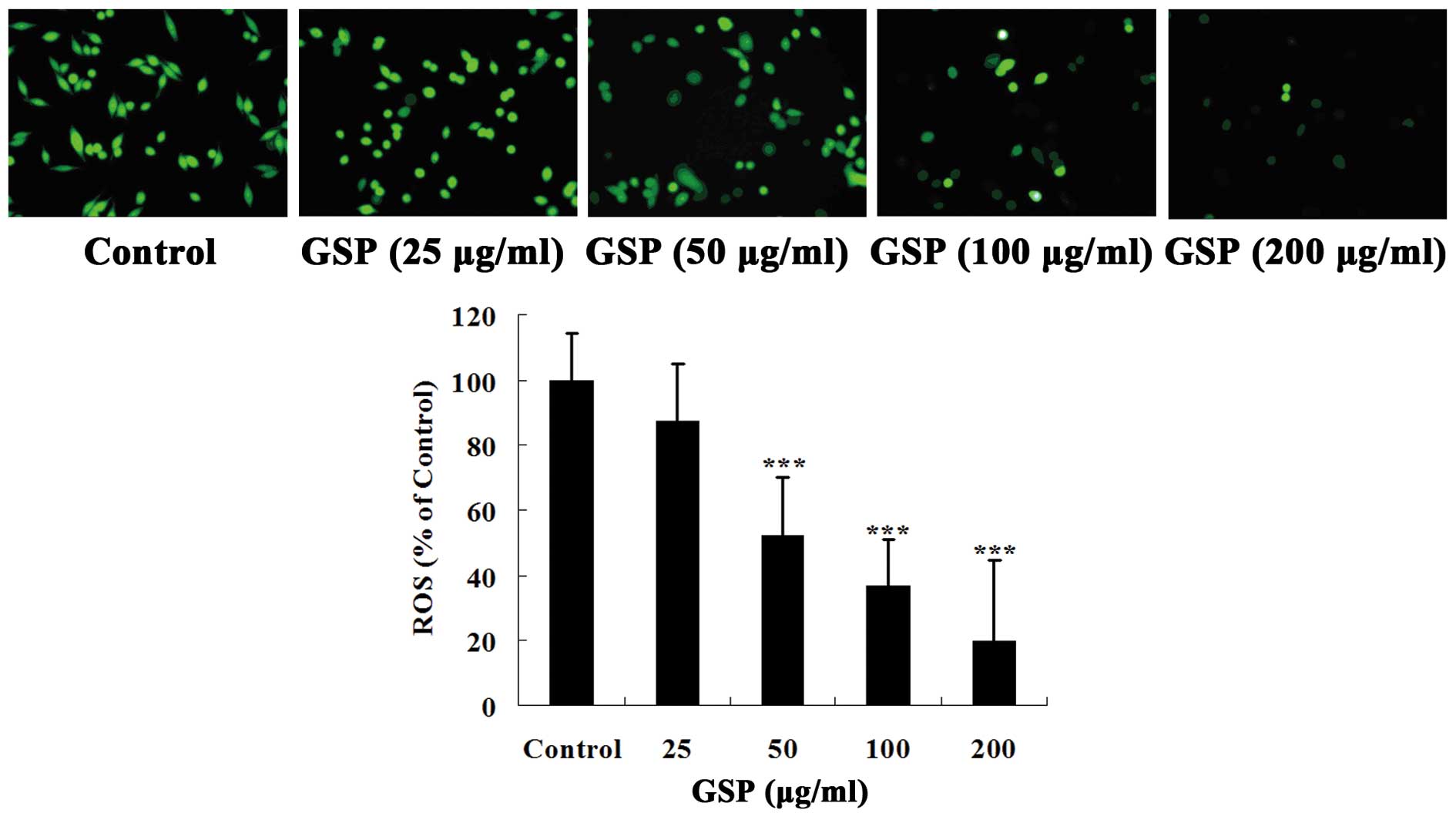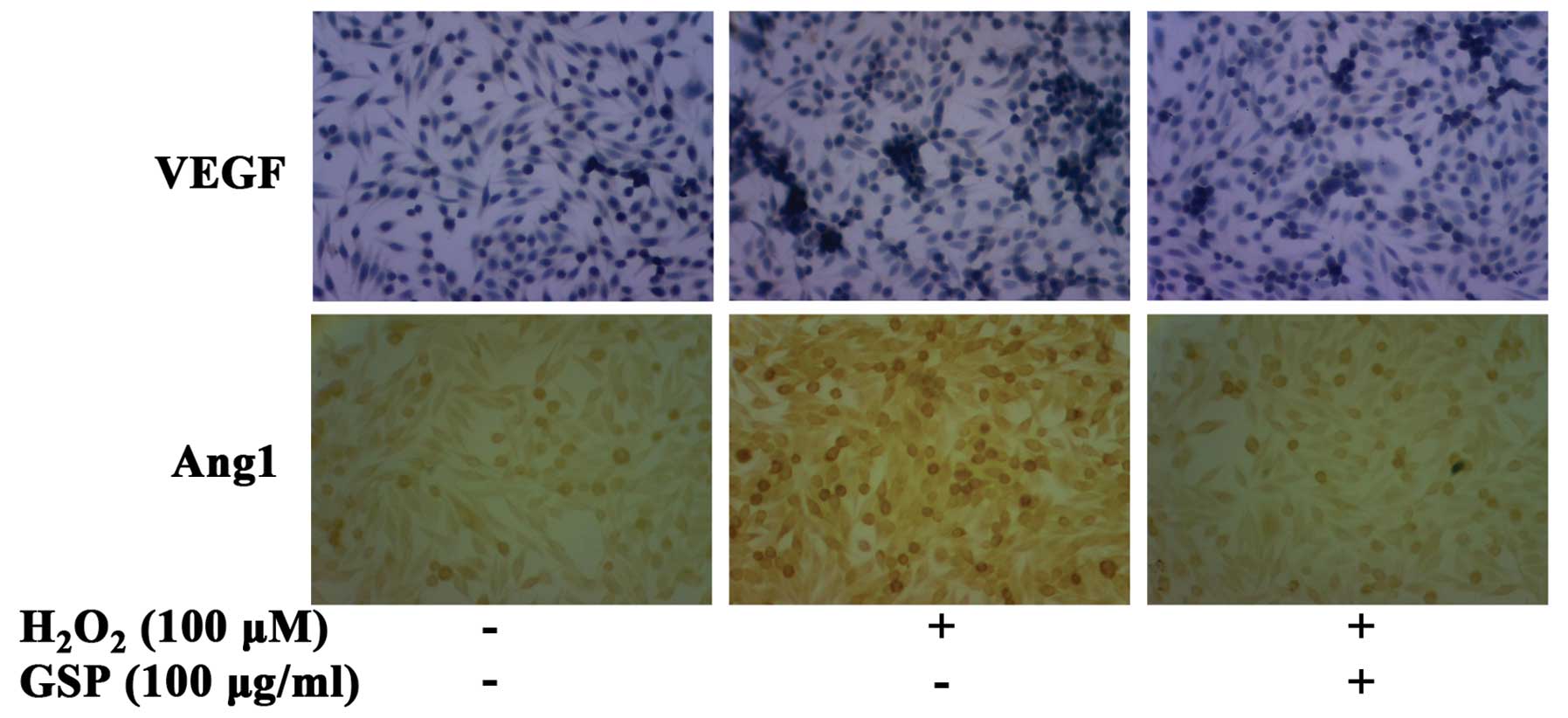Grape seed proanthocyanidins inhibit colon cancer-induced angiogenesis through suppressing the expression of VEGF and Ang1
- Authors:
- Published online on: October 1, 2012 https://doi.org/10.3892/ijmm.2012.1147
- Pages: 1410-1416
Abstract
Introduction
Angiogenesis is the formation of new blood vessels from pre-existing ones, and is required for tumor growth and metastasis. Without new blood vessel formation, the tumor cannot grow larger than 1–2 mm in diameter (1). To develop, tumors must make an ‘angiogenic switch’ by perturbing the local balance between pro- and anti-angiogenic factors in the immediate environment of endothelial cells through the overexpression of proangiogenic growth factors, such as vascular endothelial growth factor (VEGF), basic fibroblast growth factor (bFGF) and angiopoietin (Ang) (2,3). As a general mechanism, oxidative stress is a common hallmark of numerous tumors. Tumor growth produces large amounts of reactive oxygen species (ROS) (4). Previous studies have shown that ROS trigger ‘angiogenic switch’ responses by inducing VEGF expression and matrix metalloproteinase activity (5). Thus, discovery of non-toxic antiangiogenic agents from nature antioxidants targeting to inhibit the production of proangiogenic growth factors, the initial step of angiogenesis, is a promising strategy for cancer therapy and prevention.
Colon cancer is the third most commonly diagnosed cancer in men and women, with 103,170 new cases and 51,690 deaths estimated to occur in 2012 in the United States (6). The incidence of colon cancer in China is lower than that in the western countries, but it has increased in recent years and become a substantial cancer burden in China, particularly in the more developed areas (7). Epidemiological studies have shown that the regular consumption of fruits and vegetables is associated with a reduced risk of cancer (8). The beneficial effects may be partly attributable to polyphenolic compounds which have antioxidant and free radical scavenging properties (9).
Grapes are one of the most widely consumed fruits in the world and are rich in polyphenols, of which about 60–70% are found in grape seeds as dimers, trimers and other oligomers of flavan-3-ols and commonly known as proanthocyanidins. Grape seed proanthocyanidins (GSPs) are widely consumed as a dietary supplement and possess chemopreventive and/or chemotherapeutic effects in various cell culture and animal models (10,11). Pharmacokinetic studies have shown that, in vivo, GSPs can hardly be absorbed or metabolized during upper gastrointestinal tract transit, allowing these chemicals to reach the colon at high concentrations (12–14). This metabolic characteristic suggests that GSPs have a natural colon-targeting feature and are more adaptive to acting as a chemopreventive and chemotherapeutic agent for colon cancer. Epidemiological studies suggested an inverse relationship between the dietary consumption of proanthocyanidins and the risk of colorectal cancer (15,16). This is also supported by both in vitro and experimental animal studies (17–25). These studies have shown that GSPs inhibit growth and induce the apoptosis of some colon caner cell lines in vitro and in vivo. Dietary-feeding of grape seed extract also prevents azoxymethane-induced colonic aberrant crypt foci formation in Fischer 344 rats (26), suggesting that grape seed extract could inhibit the early steps of colon carcinogenesis.
In the present study, we report that GSPs inhibit tumor-induced angiogenesis, and, thus, colon tumor growth by inhibiting the expression of VEGF and Angl through scavenging ROS. Our results provide a novel explanation for GSPs as an angiopreventive agent against colon cancer.
Materials and methods
Materials
GSPs, consisting of at least 95% proanthocyanidins, 1.8% proanthocyanidin B2 and 60% oligomers were purchased from Jianfeng Co. (Tianjin, China). Leibovitz’s L-15 medium, MCDB131 medium, epithelial growth factor (EGF), hydrocortisone, sulforhodamine B (SRB) and 2′,7′-dichlorofluorescein diacetate (DCFH-DA) were purchased from Sigma (St. Louis, MO, USA). Fetal bovine serum (FBS) was purchased from Lanzhou National HyClone Bio-Engineering Co., Ltd. (Lanzhou, China). Millicell cell culture inserts were purchased from Millipore Corp. (Bedford, MA, USA). VEGF and Ang1 ELISA kits were ordered from R&D Systems (Minneapolis, MN, USA). Rabbit polyclonal anti-VEGF and rabbit polyclonal anti-Ang1 were purchased from Boster Bio-engineering Limited Co., Ltd. (Wuhan, China). MaxVision TM HRP-Polymer anti-Mouse/Rabbit IHC kit and DAB kit were purchased from Maixin Biological Technology, Ltd. (Fuzhou, China).
Cell culture
Human colon cancer SW620 cells were obtained from the Cell Bank of the Type Culture Collection of the Chinese Academy of Sciences (Shanghai, China) and were cultured in Leibovitz’s L-15 medium supplemented with 10% FBS. Human microvascular endothelial cells (HMEC-1) were cultured in MCDB131 medium supplemented with 1.18 mg/ml NaHCO3, 20% inactivated FBS, 10 ng/ml EGF and 1 μg/ml hydrocortisone. All cells were cultured in a highly humidified atmosphere of 5% CO2 at 37°C. Fertilized White Leghorn chicken eggs were obtained from the Lanzhou Institute of Biological Products (Lanzhou, China) and were incubated at 37°C in a humidified egg incubator.
Cell viability assay
The viability of SW620 cells was determined in 96-well plates by the SRB method with some modifications (27). Briefly, exponentially growing cells were seeded in 96-well plates with the final volume 100 μl/well. After 24 h of incubation, cells were treated with various concentrations of GSPs for the indicated times. The cultures were then fixed at 4°C for 1h with ice-cold 50% trichloroacetic acid to give a final concentration of 10%. Fixed cells were rinsed 5 times with deionized water and stained for 10 min with 0.4% SRB dissolved in 0.1% acetic acid. The wells were then washed 5 times with 0.1% acetic acid and left to dry overnight. The absorbed SRB was dissolved in 150 μl unbuffered 1% Tris base (pH 10.5). The absorbance of extracted SRB at 515 nm was measured on a microplate reader.
Chick chorioallantoic membrane (CAM) tumor formation assay (28,29)
Fertilized White Leghorn chicken eggs were incubated under conditions of constant humidity at a temperature of 37°C. On Day 10 of incubation, a small hole was punched over the air sac in order to detach the CAM from the eggshell by gently exhausting, and then a square window was opened on the broad side of the egg, exposing the CAM. After the CAM was exposed, 40 μl serum-free culture medium containing 1×106 SW620 cells were deposited on the CAM. The window was sealed with tape and the eggs were returned to the incubator. When the solid tumor began to vascularize after implantation for two days, GSP or vehicle was deposited locally each day. Five days later, CAM was photographed in ovo under a stereomicroscope and tumors were resected and weighed.
Enzyme-linked immunosorbent assay (ELISA)
For the measurement of VEGF and Ang1 secretion, confluent SW620 cells (90–100%) were cultured in serum-free media for 24 h in the absence or presence of GSP. Cell-free culture supernatants were harvested and used for the determination of VEGF and Ang1 levels using a human VEGF or Ang1 ELISA kit according to the manufacturer’s instructions. The concentration of the VEGF and Ang1 in the samples was then determined by comparing the optical density of the samples to the standard curve.
Preparation of tumor conditioned medium (30)
Tumor conditioned medium was prepared from the SW620 cell culture as follows: SW620 cells were grown to subconfluency (approximately 90%). After being washed twice with D-Hanks, cells were incubated in MCDB131 medium supplemented with or without 100 μg/ml GSP for 24 h. The supernatant was then harvested, centrifuged at 2000 × g at 4°C for 10 min, filter-sterilized through 0.22-μm pore size filters and stored at −20°C prior to use.
Cell migration assay
Cell migration was performed in millicell cell culture inserts using a polycarbonate filter with a pore size of 8 μm. HMEC-1 cells (2×105) suspended in 0.4 ml serum-free MCDB131 culture medium were added to the upper compartment of cell culture inserts. The lower compartment contained 0.6 ml conditioned medium. Following incubation for 24 h at 37°C, the nonmigrated cells on the upper surface of the membrane were removed with a cotton swab. The migrated cells on the lower surface of the membrane were fixed with methanol and then stained with 0.1% crystal violet. Images from randomly selected microscopic fields were obtained under light microscopy. Each sample was repeated three times.
Intracellular ROS staining
Intracellular ROS levels in both GSP-treated and control cells were measured by DCFH-DA assay as previously described (31). Briefly, sub-confluent SW620 cells were treated with different concentrations of GSP for 24 h. Following incubation, cells were washed once with D-Hanks and stained with DCFH-DA (10 μM) for 30 min. Subsequently, cells were washed twice with D-Hanks to remove the excess dye, and then 100 μl of D-Hanks was added. The images were visualized and photographed under a fluorescent microscope. During the entire procedure with DCFH-DA, the plate was kept out of light to avoid fading of the fluoroprobe.
Immunohistochemical assay for VEGF and Angl expression
Following pretreatment with or without 100 μg/ml GSP for 2 h and further incubation with or without 100 μM H2O2 for 24 h, SW620 cells seeded on glass coverslips were fixed with 4% paraformaldehyde. The expression of both VEGF and Ang1 was detected with the immunohistochemical staining kit according to the manufacturer’s instructions.
Statistical analysis
Results are expressed as the means ± SD, and were analyzed using the Student’s t-test. Values of P<0.05 were considered to indicate statistically significant differences.
Results
Effect of GSPs on the cell viability of SW620 cells
GSP treatment for 72 h significantly inhibited cell viability in a dose-dependent manner with an IC50 value of 116.44 μg/ml. However, treatment with GSP (25–200 μg/ml) for 24 h did not change cell viability (Fig. 1). Therefore, all subsequent experiments were carried out with the treatment time not exceeding 24 h.
GSPs inhibit tumor-induced angiogenesis and tumor growth in a xenografted chick chorioallantoic membrane (CAM) model
SW620 cells inoculated on chick CAM formed solid, avascular tumor within the first day. Two days after inoculation, the tumor became vascularized and grew rapidly. Five days later, numerous vessels developed radially around the tumor. Vessels at the tumor surface were clearly visible in the control group (Fig. 2A). Local treatment of the tumor from Day 3 to Day 7 (the day when SW620 cells were inoculated was designated as Day 1) with GSPs markedly inhibited tumor-induced angiogenesis. The tumor appeared white (Fig. 2B and C). The growth of the tumor was also inhibited by GSP treatment (Fig. 2D). During the experiment, some chick embryos from both the control and the GSP-treated groups died before the end of the experiment and were not included in the results shown. However, there was no significant difference in the incidence of embryonic death between GSP-treated and control groups, indicating that the inhibitory effect of GSP on tumor-induced angiogenesis was not related to toxic effects.
GSPs inhibit expression of VEGF and Ang1 in SW620 cells
Solid tumors secrete various proangiogenic factors, such as VEGF and Ang1, to activate the nearest endothelial cells in the host tissue for neoangiogenesis (32). In the present study, we investigated whether GSPs could inhibit proangiogenic attributes of colon cancer SW620 cells. GSP treatment for 24 h inhibited both VEGF and Ang1 expression in a dose-dependent manner (Fig. 3). The inhibitory effect on VEGF expression was stronger than on Ang1 expression. These results suggest that the inhibitory effect of GSPs on tumor-induced angiogenesis is partly through suppressing the expression of angiogenic factors that initiate tumor angiogenesis in SW620 cells.
Conditioned medium from GSP-treated SW620 cells inhibits cell migration of HMEC-1 cells
Both VEGF and Ang1 are chemotactic factors specific for endothelial cells. To further verify that GSPs inhibit tumor-induced angiogenesis by suppressing the expression of both VEGF and Ang1 in tumor cells, we conducted endothelial cell migration assay to examine the effect of conditioned medium from either GSP-treated or untreated SW620 cells on endothelial cell migration. Conditioned medium collected from SW620 cells induced endothelial cell migration (Fig. 4). However, endothelial cell migration was suppressed by conditioned medium collected from 100 μg/ml GSP-treated SW620 cells. These results further verified that the inhibitory effect of GSP on tumor-induced angiogenesis is mediated by reducing the expression of proangiogenic factors in SW620 cells.
GSPs inhibit the expression of VEGF and Ang1 by reducing ROS production
Excessive ROS production has been confirmed to have a vital role in the induction of VEGF or Ang1 expression in many tumor cell lines. To investigate whether the antioxidant activity is part of the mechanisms by which GSPs suppress the expression of angiogenic factors in SW620 cells, we first used fluorescent probes DCFH-DA to detect the effect of GSPs on ROS production in SW620 cells. As shown in Fig. 5, colon cancer SW620 cells had a high level of ROS. Pretreatment with GSPs significantly inhibited ROS production in a concentration-dependent manner. Thus, our data suggest that GSPs can significantly reduce the high levels of intracellular produced ROS. To further verify that the antioxidant activity is part of the mechanisms by which GSPs suppress the expression of angiogenic factors, the effects of GSPs on H2O2-induced VEGF and Ang1 expression were examined with the immunohistochemical assay. As shown in Fig. 6, 100 μM of H2O2 markedly induced both VEGF and Ang1 expression in SW620 cells. However, the expression levels of VEGF and Ang1 induced by H2O2 were suppressed by pretreatment with 100 μg/ml GSP.
Discussion
Tumor growth and metastasis are dependent on angiogenesis. Without new blood vessel formation, the tumor remains dormant and cannot grow larger than 2–3 mm in diameter. Tumors that grow beyond this size trigger angiogenesis by producing proangiogenic factors. Among these molecules, VEGF and Ang1 are the prime proangiogenic factors for sustaining tumor growth. Therefore, inhibition of both VEGF and Ang1 production, the initial step of tumor angiogenesis, is a promising strategy for cancer chemoprevention and therapy. In the current study, GSPs inhibited the colon tumor-induced angiogenesis and, thus, the growth of colon tumor xenograft on the chick CAM without any apparent sign of toxicity. Previous studies have demonstrated that the chemopreventive effects of GSPs for colon cancer are associated with their growth inhibitory and apoptosis-inducing effects. Our results, provide another mechanism by which GSPs inhibit colon tumor growth.
To better understand the mechanism by which GSPs inhibit the tumor-induced angiogenesis, we examined the effect of GSPs on the expression of proangiogenic factors by colon tumor cells. We found that GSP treatment exerted significant inhibitory effects on both VEGF and Angl expression. The result was further supported by the endothelial cell migration assay, which showed that conditioned medium from GSP-treate d SW620 cells exhibited greater inhibitory effects on endothelial cell migration than its untreated counterparts. This conclusion is consistent with previous findings that GSPs inhibit VEGF secretion from DU145 prostate cancer cells (33). Among many proangiogenic factors, both VEGF and Ang1 regulate different, but complementary, aspects of blood vessel growth in tumors by binding their receptor expressed on the endothelial cells. The former is responsible for new blood vessel formation, while the latter contributes to new blood vessel maturation and stabilization (32). Our observations indicate that GSPs inhibit both sprouting angiogenesis and maturation of blood vessels.
Both VEGF and Ang1 expression is regulated by several factors, including hypoxia-inducible factor-1 (HIF-1), in response to hypoxia (34). HIF-1 is a heterodimeric that consists of a constitutively expressed HIF-1β subunit and a HIF-1α subunit, the expression of which is highly regulated. Under normal oxygen conditions, the HIF-1α protein is hydroxylated by the prolyl hydroxylase enzymes (PHDs), thereby facilitating ubiquitination and subsequent proteasomal degradation (35). It has been reported that ROS generated from mitochondria are required for the stabilization of HIF-1α (36). A previous study also showed that endogenous ROS regulate tumor-induced angiogenesis and tumor growth through HIF-1α and VEGF expression in ovarian cancer cells (37). To understand whether the inhibition of GSPs on VEGF and Ang1 expression from SW620 cells may be mediated through their ROS scavenging activity, resulting blocking ROS/HIF-1α/VEGF or Ang1 pathway, we examined the effect of GSPs on intracellular ROS levels at first. The results of our study showed that GSPs significantly reduced ROS levels in SW620 cells. Our results also showed that treatment with 100 μM hydrogen peroxide stimulated both VEGF and Ang1 expression, while pretreatment with GSPs inhibited both VEGF and Ang1 expression. These results suggested that inhibition of VEGF and Ang1 expression by GSPs might partially attribute to their anti-oxidative activity.
It has been reported that GSPs, due to their polymeric structure, are poorly absorbed along the gastrointestinal tract and can reach the colon at concentrations of several hundred micromoles per liter, allowing these chemicals to act locally. These results, combined with our previous results that GSPs inhibit angiogenesis by inhibiting VEGF receptor 2 and receptor of Ang1 (Tie2) phosphorylation (38), indicate that GSPs are effective antiangiogenic agents by acting on both tumor and endothelial cells. Therefore, the results of the present study indicate that GSPs could be used as an effective, non-toxic antiangiogenic agent for colon cancer.
Acknowledgements
This study was supported by a grant from the National Natural Science Foundation of China (no. 30700142 to S.H.) and the Scientific Research Innovation Team of Northwest University for Nationalities (no. BMUCXTD-2011-1).



